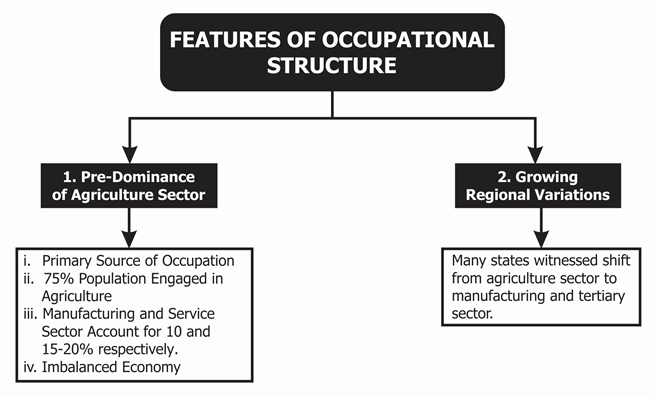What is Occupational Structure?
The occupational structure of a nation refers to the percentage of its workforce employed in various economic ventures. To put it in other words, articulating the number of the total working population employed in agriculture and associated activities and the number of them involved in the manufacturing and service sectors can be identified from the occupational structure of the nation.
Occupational Structure in Colonial India
During the colonial period, the occupational structure of India, i.e., the allocation of working people across various industries and sectors, explicated small hints of change. The agricultural sector valued for the highest share of the workforce, which normally prevailed at a high of 70–75%, while the manufacturing and service sectors estimated for only 10 and 15-20% sequentially. Another outstanding perspective was the growing geographical variation. Parts of the then Madras Presidency (including areas of the present-day states of Tamil Nadu, Kerala, Andhra Pradesh, and Karnataka), Bombay, and Bengal observed a drop in the dependence of the workforce on the agricultural sector with a corresponding increase in the production and the services sectors. However, there was an increase in the share of the workforce in agriculture during the same time in the states like Rajasthan, Odisha, and Punjab.
Also read: Indian Industries during British rule
Features of Occupational Structure

Following are the features of India’s occupational structure:
Predominance of the agricultural sector
- Agriculture was the principal source of occupation.
- 75% of the population was engaged in agriculture, resulting in the backwardness of the Indian economy at the time of India’s independence.
- The manufacturing and service sectors accounted for only 10% and 15-20% , respectively.
- The growth of all the three sectors was unbalanced.
Growing regional variations
States like Tamil Nadu, Andhra Pradesh, Kerala, Karnataka, Maharashtra, and West Bengal witnessed a shift of dependence of the workforce from the agricultural sector to manufacturing and the service sectors.
However, there had been an increase in the share of the workforce in agriculture during the same time in states such as Odisha, Rajasthan, and Punjab.
Recommended links: Class 11 Economics Important Question
Multiple Choice Questions
| Q1. Which of the following is not a characteristic of the Indian economy on the eve of India’s independence? |
| a. Small and fragmented land holdings
b. Use of outdated and old technology c. Commercial farming d. Low level of productivity |
| Q2. During the British rule, which of the following commercial crops were the farmers forced to grow? |
| a. Wheat
b. Rice c. Cotton d. Indigo |
| Q3. Who estimated India’s per capita income during colonial rule? |
| a. Dadabhai Naoroji
b. William Digby c. R.C. Desai d. All of the above |
| Q4. Nearly ___________ percent of the Indian population was earning a livelihood from agriculture on the eve of India’s independence. |
| a. 85
b. 95 c. 75 d. 55 |
| Q5. ______________farming is the one where the primary objective of the farmer is to produce for their own family. |
| a. Consistent
b. Step c. Subsistence d. None of the above |
| Answer Key |
| 1-c, 2-d, 3-d, 4-c, 5-c |
| Also, Explore: |
For more data on Economics Class 11 Syllabus, Commerce notifications and sample papers for Class 11 Commerce, stay tuned to BYJU’S.
Very nice
It is only the best web site for CBSE students even existed with so easy language and highlights important
points and topics. One can totally depend on it and give up going to tuition and other online site.